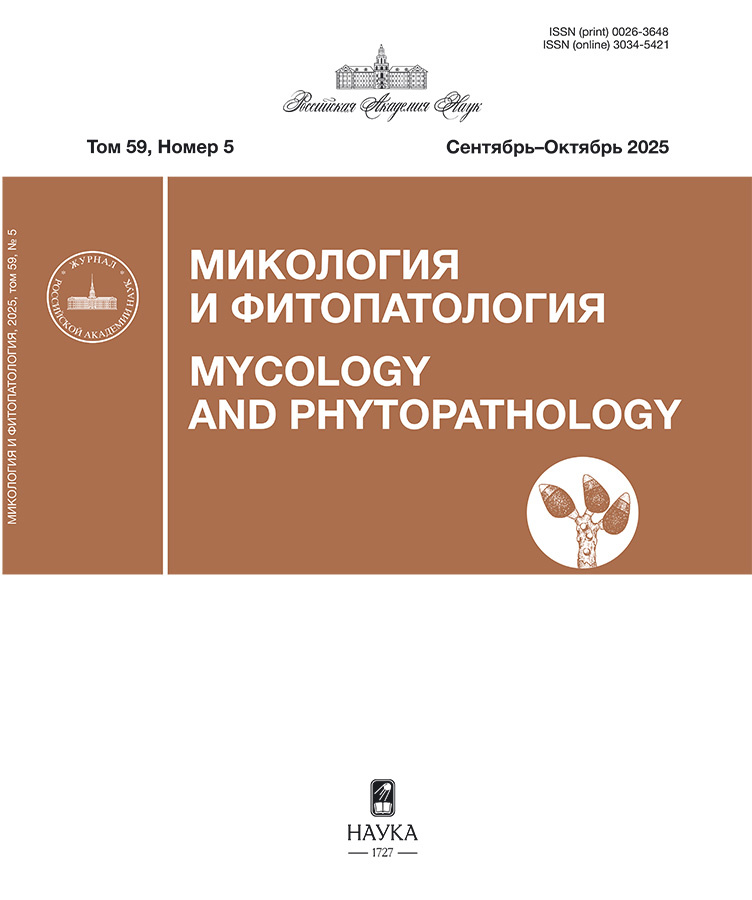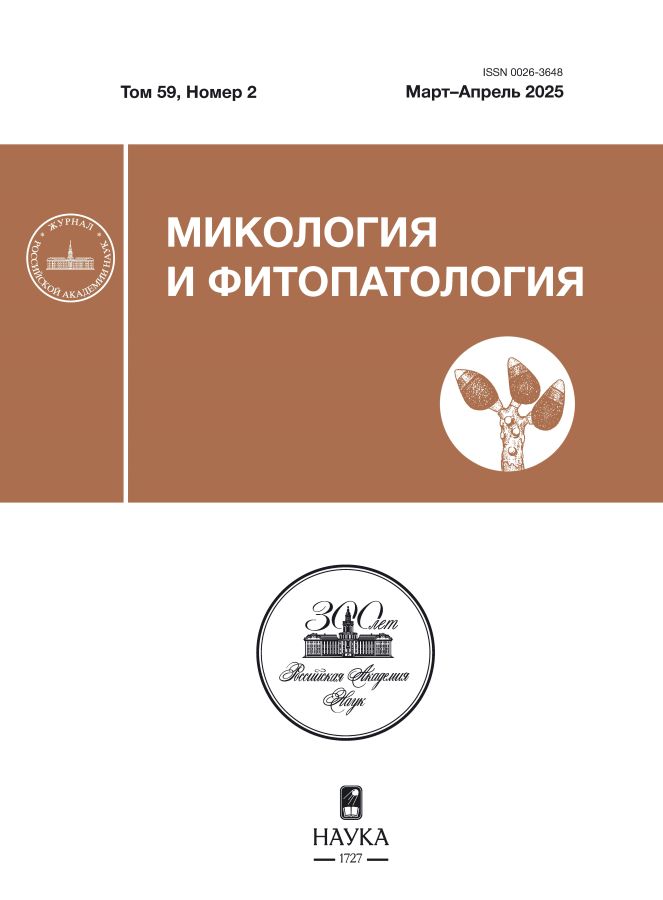Грибы рода Fusarium на растениях томата в России
- Авторы: Ярмеева М.М.1, Чудинова Е.М.2, Еланская А.С.1, Кокаева Л.Ю.1,2, Еланский С.Н.1,2
-
Учреждения:
- Московский государственный университет им. М. В. Ломоносова
- Российский университет дружбы народов имени Патриса Лумумбы
- Выпуск: Том 59, № 2 (2025)
- Страницы: 169-180
- Раздел: ГРИБЫ – ВОЗБУДИТЕЛИ БОЛЕЗНЕЙ РАСТЕНИЙ
- URL: https://rjsocmed.com/0026-3648/article/view/683482
- DOI: https://doi.org/10.31857/S0026364825020058
- EDN: https://elibrary.ru/sqoxky
- ID: 683482
Цитировать
Полный текст
Аннотация
Томат (Solanum lycopersicum) – одна из самых популярных овощных культур в России. Среди патогенов томата грибы рода Fusarium одни из самых опасных, они вызывают фузариозное увядание растений и гниль плодов. В настоящей работе молекулярными методами исследован видовой состав и определена патогенность изолятов рода Fusarium, выделенных из растений томата в разных регионах России. Органы томата с симптомами поражения грибными болезнями отбирали во время вегетации на коммерческих полях открытого грунта в Московской, Астраханской, Саратовской областях и в Краснодарском крае. Из анализируемых образцов было выделено 25 изолятов рода Fusarium: 19 из плодов, два с листьев, один из стебля и три из корней. Анализ видового разнообразия по специфичным участкам ДНК tef1α и β-tub показал, что анализируемые изоляты принадлежали к девяти видам из трех видовых комплексов: Fusarium incarnatum-equiseti species complex (F. citri, F. clavum, F. compactum, F. luffae), F. fujikuroi species complex (F. annulatum, F. proliferatum), F. oxysporum species complex (F. curvatum, F. fabacearum, F. nirenbergiae). Штамм F. curvatum был выделен из корней пораженного фузариозным увяданием куста; штаммы F. fabacearum были выделены из корней куста без видимых симптомов увядания и из плода, F. luffae – из стебля и плода. Два штамма F. clavum были выделены из листьев с темными некротическими пятнами. Штаммы видов F. citri, F. clavum, F. compactum, F. annulatum, F. proliferatum, F. nirenbergiae были выделены из плодов с симптомами грибного поражения. Все проанализированные штаммы успешно заражали плоды томата и клубни картофеля в тесте с инокуляцией уколом суспензией спор. Наиболее агрессивными видами оказались F. compactum и F. nirenbergiae, причем F. compactum заражал и здоровые плоды с ненарушенной кожурой. Штаммы F. clavum также заражали здоровые плоды томата, но инфекция в них развивалась медленнее, чем при заражении F. compactum. В работе впервые показана патогенность для томата видов F. compactum, F. annulatum, F. fabacearum, F. nirenbergiae. Полученные результаты предоставляют дополнительную информацию о разнообразии видов Fusarium, развивающихся на пораженных органах томата.
Ключевые слова
Полный текст
Об авторах
М. М. Ярмеева
Московский государственный университет им. М. В. Ломоносова
Автор, ответственный за переписку.
Email: mari.yarmeeva@mail.ru
Россия, 119991, Москва
Е. М. Чудинова
Российский университет дружбы народов имени Патриса Лумумбы
Email: chudiel@mail.ru
Россия, 117198, Москва
А. С. Еланская
Московский государственный университет им. М. В. Ломоносова
Email: elanskaya034@mail.ru
Россия, 119991, Москва
Л. Ю. Кокаева
Московский государственный университет им. М. В. Ломоносова; Российский университет дружбы народов имени Патриса Лумумбы
Email: kokaeval@gmail.com
Россия, 119991, Москва; 117198, Москва
С. Н. Еланский
Московский государственный университет им. М. В. Ломоносова; Российский университет дружбы народов имени Патриса Лумумбы
Email: snelansky@mail.ru
Россия, 119991, Москва; 117198, Москва
Список литературы
- Abu Bakar A.I., Nur Ain Izzati M.Z. Vegetative compatibility groups within Fusarium species isolates from tomato in Selangor, Malaysia. Pertanika Journal of Tropical Agricultural Science. 2018. V. 41(4). P. 1853–1864. http://agris.upm.edu.my:8080/dspace/handle/0/17200
- Azil N., Stefańczyk E., Sobkowiak S. et al. Identification and pathogenicity of Fusarium spp. associated with tuber dry rot and wilt of potato in Algeria. Eur. J. Plant Pathol. 2021. V. 159 (3). P. 495–509. https://doi.org/10.1007/s10658-020-02177-5
- Bedoya E.T., Bebber D.P., Studholme D.J. Taxonomic revision of the banana Fusarium Wilt TR4 pathogen is premature. Phytopathology. 2021. V. 1 (11). P. 2141–2145. https://doi.org/10.1094/phyto-03-21-0089-le
- Beltran M., Delgado J.C., Valdivia A.G. et al. First report of Fusarium equiseti causing root and crown rot in tomato in Mexico. Plant Disease. 2023. V. 107. P. 2542. https://doi.org/10.1094/pdis-10-22-2494-pdn
- Chitwood-Brown J., Vallad G.E., Lee T.G. et al. Breeding for resistance to Fusarium wilt of Tomato: A Review. Genes. 2021. V.12. Art. 1673. https://doi.org/10.3390/genes12111673
- Crous P.W., Lombard L., Sandoval-Denis M. et al. Fusarium: more than a node or a foot-shaped basal cell. Stud. Mycol. 2021. V. 98. Art. 100116. https://doi.org/10.1016/j.simyco.2021.100116
- Debbarma R., Kamil D., Bashyal B.M. et al. First report of crown and stem rot of tomatoes (Solanum lycopersicum L.) caused by Fusarium solani in India. J. Plant Pathol. 2021. V. 103. Art. 1373. https://doi.org/10.1007/s42161-021-00938-7
- Du M., Ren X., Sun Q. et al. Characterization of Fusarium spp. causing potato dry rot in China and susceptibility evaluation of Chinese potato germplasm to the pathogen. Potato Res. 2012. V. 55. P. 175–184. https://doi.org/10.1007/s11540-012-9217-6
- Elansky A.S., Mislavskiy S.M., Chudinova E.M. et al. Fusarium species affecting potato tubers and tomato fruits in Uganda. Mikologiya i fitopatologiya. 2024. V. 58 (2). P. 161–172. https://doi.org/10.31857/S0026364824020077
- Elansky A.S., Simbo D., Elansky S.N. et al. Fusarium fungi from diseased potato tubers and tomato fruits in Mali. Mikologiya i fitopatologiya. 2025. V. 59 (in press).
- Fajola A.O. The post-harvest fruit rots of Tomato (Lycopersicum esculentum) in Nigeria. Food/Nahrung. 1979. V. 23. P. 105–109. https://doi.org/10.1002/food.19790230202
- FAO. 2024. https://www.fao.org/faostat/en/#data/QCL. Accessed 04.12.2024.
- Gachango E., Hanson L.E., Rojas A. et al. Fusarium spp. causing dry rot of seed potato tubers in Michigan and their sensitivity to fungicides. Plant Disease. 2012. V. 96. P. 1767–1774. https://doi.org/10.1094/pdis-11-11-0932-re
- Gagkaeva T. Yu., Orina A.S., Gomzhina M.M. et al. Fusarium bilaiae, a new cryptic species in the Fusarium fujikuroi complex associated with sunflower. Mycologia. 2023. V.115(6). P. 787–801. https://doi.org/10.1080/00275514.2023.2259277
- Gao M.L., Luan Y.S., Yu H.N. et al. First report of tomato leaf spot caused by Fusarium proliferatum in China. Can. J. Plant Pathol. 2016. V. 38 (3). P. 400–404. https://doi.org/10.1080/07060661.2016.1217277
- Geiser D.M., Al-Hatmi A.M., Aoki T. et al. Phylogenomic analysis of a 55.1-kb 19-gene dataset resolves a monophyletic Fusarium that includes the Fusarium solani species complex. Phytopathology. 2021. V. 111 (7). P. 1064–1079. https://doi.org/10.1094/phyto-08-20-0330-le
- Gilardi G., Matic S., Guarnaccia V. et al. First report of Fusarium clavum causing leaf spot and fruit rot on tomato in Italy. Plant Disease. 2021. V. 105 (8). Art. 2250. https://doi.org/10.1094/pdis-05-20-1096-pdn
- Liu J., Deng S., Chang W., Wang H. First report of tomato wilt caused by Fusarium brachygibbosum in China. Plant disease. 2023. V. 107 (9). P. 2844. https://doi.org/10.1094/PDIS-01-23-0076-PDN
- Lombard L., Sandoval-Denis M., Lamprecht S.C. et al. Epitypification of Fusarium oxysporum – clearing the taxonomic chaos. Persoonia. 2019. V. 43. P. 1–47. https://doi.org/10.3767/persoonia.2019.43.01
- Maryani N., Lombard L., Poerba Y.S. et al. Phylogeny and genetic diversity of the banana Fusarium wilt pathogen Fusarium oxysporum f. sp. cubense in the Indonesian centre of origin. Stud. Mycol. 2019. V. 92. P. 155–194. https://doi.org/10.1016/j.simyco.2018.06.003
- Murad N.B.A., Kusai N.A., Zainudin N.A.I.M. Identification and diversity of Fusarium species isolated from tomato fruits. J. Plant Protection Res. 2016. V.56. P. 231–236. https://doi.org/10.1515/jppr-2016-0032
- Mwangi M.W., Muiru W.M., Kimenju J.W. Characterisation of Fusarium species infecting tomato in Mwea West Sub-county, Kirinyaga County, Kenya. Can. J. Plant Pathol. 2021. V. 43 (1). P. 56–61. https://doi.org/10.1080/07060661.2016.1217277
- O’Donnell K., Kistler H.C., Cigelnik E. et al. Multiple evolutionary origins of the fungus causing Panama disease of banana: concordant evidence from nuclear and mitochondrial gene genealogies. PNAS USA. 1998. V. 95 (5). P. 2044–2049. https://doi.org/10.1073/pnas.95.5.2044
- O’Donnell K., Sutton D.A., Rinaldi M.G. et al. Internet-accessible DNA sequence database for identifying fusaria from human and animal infections. J. Clin. Microbiol. 2010. V. 48 (10). P. 3708–3718. https://doi.org/10.1128/jcm.00989-10
- O’Donnell K., Ward T.J., Robert V.A. et al. DNA sequence-based identification of Fusarium: current status and future directions. Phytoparasitica. 2015. V. 43. P. 583–595. https://doi.org/10.1007/s12600-015-0484-z
- O’Donnell K., Whitaker B.K., Laraba I. et al. DNA sequence-based identification of Fusarium: A work in progress. Plant Disease. 2022. V. 106 (6). P. 1597–1609. https://doi.org/10.1094/pdis-09-21-2035-sr
- Severo R., Shibutani L.J.S., Silva G.F. et al. Fusarium species causing root rot and wilt in tomato in Brazil. Journal of Phytopathology. 2024. V. 172. Art. e13261. http://dx.doi.org/10.1111/jph.13261
- Srinivas C., Devi D.N., Murthy K.N.et al. Fusarium oxysporum f. sp. lycopersici causal agent of vascular wilt disease of tomato: Biology to diversity. A review. Saudi J. Biol. Sci. 2019. V. 26 (7). P. 1315–1324. https://doi.org/10.1016/j.sjbs.2019.06.002
- Sun X., Jiang S., Hong H. et al. First report of fruit rot caused by Fusarium luffae in cherry tomato in China. Plant Di-sease. 2024. V. 108 (3). Art. 788. https://doi.org/10.1094/pdis-05-23-1019-pdn
- Wang M.M., Crous P.W., Sandoval-Denis M. et al. Fusarium and allied genera from China: species diversity and distribution. Persoonia. 2022. V. 48. P. 1–53. https://doi.org/10.3767/persoonia.2022.48.01
- Watanabe M., Yonezawa T., Lee K.I. et al. Molecular phylogeny of the higher and lower taxonomy of the Fusarium genus and differences in the evolutionary histories of multiple genes. BMC Evolutionary Biol. 2011. V. 11 (1) P. 1–16. https://doi.org/10.1186/1471-2148-11-322
- Xia J.W., Sandoval-Denis M., Crous P.W. et al. Numbers to names – restyling the Fusarium incarnatum-equiseti species complex. Persoonia. 2019. V. 43. P. 186–221. https://doi.org/10.3767/persoonia.2019.43.05
- Yilmaz N., Sandoval-Denis M., Lombard L., et al. Redefining species limits in the Fusarium fujikuroi species complex. Persoonia. 2021. V. 46. P. 129–162. https://doi.org/10.3767/persoonia.2021.46.05
Дополнительные файлы













